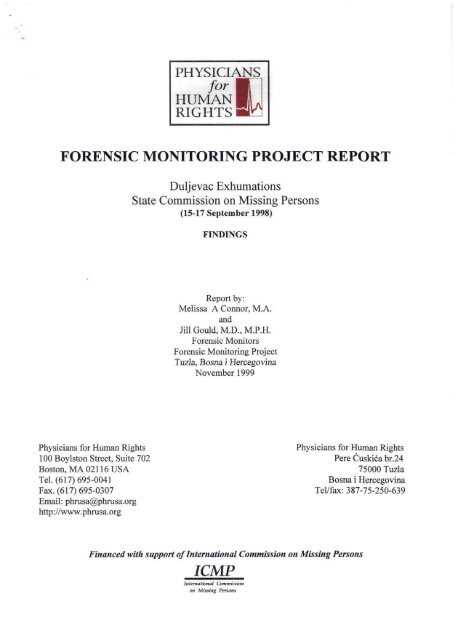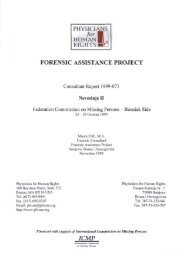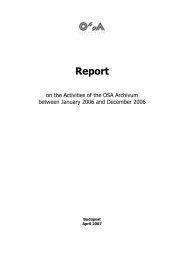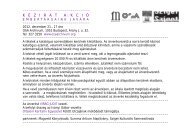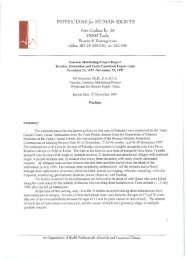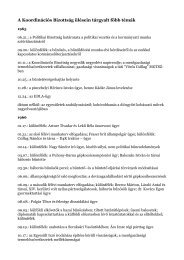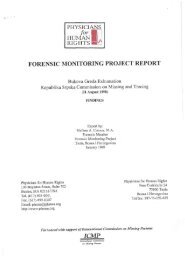forensic monttoring project report - OSA Archivum
forensic monttoring project report - OSA Archivum
forensic monttoring project report - OSA Archivum
Create successful ePaper yourself
Turn your PDF publications into a flip-book with our unique Google optimized e-Paper software.
PHYSICIANS ^N^><br />
for<br />
HUMAN<br />
RIGHTS<br />
FORENSIC MONTTORING PROJECT REPORT<br />
Duljevac Exhumations<br />
State Commission on Missing Persons<br />
(15-17 September 1998)<br />
FINDINGS<br />
Report by:<br />
Melissa A Connor, M.A.<br />
and<br />
Jill Gould, M.D., M.P.H.<br />
Forensic Monitors<br />
Forensic Monitoring Project<br />
Tuzla, Bosna i Hercegovina<br />
November 1999<br />
Physicians for Human Rights<br />
100 Boylston Street, Suite 702<br />
Boston, MA 02116 USA<br />
Tel. (617)695-0041<br />
Fax. (617) 695-0307<br />
Email: phrusa@phrusa.org<br />
http://www.phrusa.org<br />
Physicians for Human Rights<br />
Pere Cuskica br.24<br />
75000 Tuzla<br />
Bosna i Hercegovina<br />
Tel/fax: 387-75-250-639<br />
Financed with support of International Commission on Missing Persons<br />
ICMP<br />
Intrrnatiimal Cummissiitn<br />
on Missing Persons
DULJEVAC EXHUMATIONS<br />
Summary of Events<br />
The State Commission on Missing Persons (Bosniak) exhumed 24 sets of remains from a<br />
single grave near Duljevac, south of Rogatica, on 15-17 November, 1998. The grave was<br />
allegedly that of men killed in 1992. The witnesses <strong>report</strong>ed that the men had been taken<br />
from a prison near Rogatica, used as a human shield in the fighting, and executed. PHR<br />
Forensic Monitor Melissa Connor was present for, and participated in, the exhumations.<br />
The autopsies were conducted at the mortuary in Visoko on 23 and 25 September, 1998. Dr.<br />
Hamza Zujo, Forensic Pathologist, presided over the autopsies. Forensic Monitors Melissa<br />
Connor and Dr. Jill Gould were present for, and participated in, the autopsies. Of the 24<br />
autopsies monitored, 13 decedents sustained gunshot wounds to the head. Injuries involving<br />
the bones were seen in all but one case. Cause of death was documented in all cases with the<br />
exception of four. Specific bone abnormalities were documented which may enhance future<br />
identification of the remains in several of the other cases.<br />
PHYSlClANS/or HUMAN RIGHTS, November 1999 1
DULJEVAC EXHUMATIONS<br />
Participants and Observers (not all inclusive)<br />
State Commission on Missing Persons (Bosniak)<br />
BESIC Sead<br />
Crime Technician, Sarajevo<br />
DRAGANOVIC Kemal Member<br />
HRNJ1C Saudin<br />
Autopsy Assistant, Sarajevo<br />
KLONOWSKI Dr. Eva Forensic Anthropologist<br />
KOSO Sejid<br />
Member<br />
NIKSIC Muhidin<br />
Judge, Cantonal Court, Sarajevo<br />
MASOVIC Amor<br />
President<br />
MUJKIC Muhamed<br />
Archivist, Crime Technician, Sarajevo<br />
MUSIC Adnan<br />
Autopsy Assistant, Sarajevo<br />
SARAJL1C Nermin<br />
Forensic Pathology Student, Sarajevo<br />
TARl£ Ermin<br />
Crime Technician, Sarajevo<br />
ZUJO Dr. Hamza<br />
Forensic Pathologist, Sarajevo<br />
Laborers from the Visiko City Cemetery<br />
Republika Srpska Commission on Missing and Tracing<br />
SKRBA Slobadan<br />
Member<br />
Physicians for Human Rights<br />
CONNOR Melissa<br />
GOULD Dr. Jill<br />
LIVADIC Mirela<br />
SPAHIC Lejla<br />
Office of the High Representative<br />
ZOFAL Werner<br />
BECO Abdel<br />
Forensic Monitor<br />
Forensic Monitor<br />
Translator<br />
Translator<br />
Exhumations Officer<br />
Translator<br />
Representatives from the International Police Task Force (IPTF) and the Stabilization Force<br />
(SFOR) were also present.<br />
Site Description<br />
The town of Rogatica is in a wide portion of the Rakitnica River valley, at the confluence of<br />
the Rakitnica and Sutjeska Rivers (Figure 1) (DMA Map Rogatica, Edition 5-DMA, Scries<br />
M709, Scale 1:50,000, Sheet 2882 I). The town, at an elevation of 600 meters, is surrounded<br />
by steep, rugged hills covered in forest and vegetation.<br />
Duljevac is a small hamlet in the mountains to the south of Rogatica. The road to the hamlet<br />
goes through PaSic Kula and along a cobble road before disappearing into a dirt two-track<br />
road that is difficult for two-wheel drive vehicles. Before getting to the grave site, the road<br />
passes a bunker to the left. The grave, at grid coordinates 34T CP 415E 462N, is located just<br />
north of a second bunker that can also be seen from the road. The grave is in a grass-covered<br />
sheep pasture on a south-east facing slope overlooking the Ljutafia valley.<br />
PHYSIClANS/or HUMAN RIGHTS, November 1999 2
DULJEVAC EXHUMATIONS<br />
Site History<br />
Fighting in and around Rogatica was heavy in 1992. According to a 1996 <strong>report</strong> by the State<br />
Commission for Gathering Facts on War Crimes, shelling of Rogatica began on 14 May<br />
1992, and intense fighting continued through June and July 1992 (Missing Persons - Analysis<br />
of Causes and Circumstances in Territory of Bosnia and Herzegovina April 1992<br />
December 1995, State Commission for Gathering Facts on War Crimes, Bosnia and<br />
Herzegovina Presidency, Sarajevo, December 1996). The <strong>report</strong> says that when areas were<br />
captured, men would frequently be separated from women and children, and on several<br />
occasions, the latter were driven into Bosniak territory. In many cases, the men have not<br />
been heard from since and are counted among the missing. Fighting in the villages<br />
surrounding Rogatica continued through June, July, and August.<br />
The witness(es) alleged that over 30 men were taken from the prison in Rogatica to the area<br />
near Duljevac to be used as a human shield in the lighting near the grave site. The Bosniak<br />
position was several hundred meters from the Bosnian Serb position, the area of the grave<br />
site. After their use as a human shield, witnesses said the men were executed on the site. The<br />
witness(es) were men who had been shot, but survived. They crawled out from under other<br />
bodies and escaped after the Bosnian Serb forces left the immediate area.<br />
There were no witnesses to the burial. The exhumation team had talked to people who had<br />
seen smoke rising from the general area and believed the bodies might have been burned.<br />
Exhumation Process and Condition of Remains<br />
Upon arrival at the alleged grave site, the exhumation team showed the de-miner where they<br />
thought the grave site was located. This initial location was near a charred tree. The team<br />
may have chosen this area because they believed the remains may have been burned. The deminer<br />
used a metal detector and a probe to examine the immediate area around the tree. This<br />
area was delimited using police tape (Figure 2). The crime technicians then photographed the<br />
area using still and digital photography, as well as video.<br />
Laborers used picks and shovels to excavate trenches along the treeline parallel to the road, as<br />
well as several trenches perpendicular to the treeline. No signs of disturbed soil or human<br />
remains were found. The next day, the team returned with a backhoe. Additional trenching<br />
was completed, concentrating again on the treeline parallel to the road and the perpendicular<br />
treeline on the south side of the field. A soil probe was also used to try to locate the remains.<br />
Finally, a metal detector was brought out to search the area for a concentration of cartridges<br />
that might have resulted from the executions. A concentration of metal detector "hits" was<br />
found in the southwest corner of the field, less than 5 m from two of the previous trenches<br />
(Figure 3). While excavating these "hits," human bone was found. The excavations were<br />
expanded until the entire grave was uncovered.<br />
The remains were uncovered and cleaned by the Forensic Pathologist, Dr. Zaijo, his<br />
assistants, Mr. MaSovic, the PHR Forensic Monitor, and/ or Dr. Klonowski. The Crime<br />
Technicians photographed the exposed remains and any associated artifacts. A combination<br />
of the five people listed above lifted the remains into the body bag(s) that had been labeled by<br />
the Crime Technicians and/or the Pathologist's Assistant. Evidence found directly associated<br />
with remains was photographed and placed in the body bag with the remains. Evidence<br />
PHYSICIANS/or HUMAN RIGHTS, November 1999 3
DULJEVAC EXHUMATIONS<br />
found not directly associated with remains was photographed and collected separately.<br />
Before loading the body bags into the truck and leaving the site, the Crime Technicians<br />
photographed the remains inside each body bag.<br />
The grave was a maximum of about 1.1m deep and 4.5 m north/south by 3 m east/west.<br />
Within the grave itself was a large mass of remains running north to south. This is the mass<br />
where most of the remains and where the most articulated remains occurred (Area C, Figure<br />
4). To the northeast of this main mass (Area D, Figure 4), disarticulated elements were<br />
located with a series of identification documents. Only one document, a credit card, was still<br />
legible. The name on this document matched one of the names on the list of people whom<br />
the witnesses alleged should be in the grave. This pile of documents gave the impression that<br />
the wallets and papers from several of the bodies had been collected and thrown into the<br />
grave in one place.<br />
An area to the north - northwest of the main body mass (Area A, Figure 4) contained three<br />
crania (Crania 1, 2, and 3) with multiple cervical vertebrae each, but disarticulated from the<br />
rest of each body. Al the top of the main body mass lay two additional crania that were also<br />
disassociated from the post-cranial remains. Several sets of remains in the main body mass<br />
were complete except for the crania and some vertebrae, and the articular surfaces on the<br />
vertebrae were matched in the field. Other broken, disarticulated, elements were in this<br />
island of remains (Area A) and to the northeast of the main body mass (Areas D and E), and<br />
added to the impression that the remains were buried after disarticulation had occurred.<br />
The grave taphonomy suggests the bodies laid on the surface for a while after death. This is<br />
evident from the maggot cases found throughout the remains. Also, the remains were<br />
partially disassociated in a manner consistent with their being decomposed enough to fall<br />
apart during the burial. In part of the grave, particularly in the southeast corner, the remains<br />
were charred. The soil under these remains was burned, suggesting the remains had been<br />
burned in place. Two cartridge cases were found in the grave.<br />
No clothing was found with the exhumed remains. Shoes and boots were recovered, but no<br />
determination was made as to whether these were of civilian or military type.<br />
Postmortem Examination Findings<br />
The autopsies were carried out on 22, 23, and 25 September 1998 at the mortuary in Visoko.<br />
Dr. Hamza Zujo, Forensic Pathologist, presided over the autopsies. PHR Forensic Monitor<br />
Melissa Connor was present the first day, and PHR Forensic Monitor Dr. Jill Gould was<br />
present the remaining days. The same pathology assistants were present as were in the field.<br />
The first day of the autopsies consisted of associating the commingled remains. Twentyeight<br />
bags of remains were removed from the field, along with an unnumbered body bag of<br />
disassociated remains. At the end of the osteoiogical analysis, 24 relatively complete sets of<br />
remains were examined (Table 1), and two sets of partial remains were set aside for<br />
examination at a later date. The general procedure for the examination was to carry the body<br />
into the autopsy room, unzip the body bag, photograph the remains, describe the clothing, and<br />
examine the body for sex, age, trauma, and cause of death.<br />
PHYSICIANS/or HUMAN RIGHTS, November 1999 -1
DULJEVAC EXHUMATIONS<br />
Table 1. Summary of Postmortem Examination of Remains from Duljevac.<br />
Date of<br />
Autopsy<br />
23/9/98<br />
23/9/98<br />
23/9/98<br />
23/9/98<br />
23/9/98<br />
Body<br />
No.<br />
1<br />
2<br />
3<br />
4<br />
5<br />
State of<br />
Remains<br />
Skeletal<br />
Skeletal<br />
Skeletal<br />
Skeletal<br />
Skeletal<br />
Sex<br />
Male<br />
Male<br />
Male<br />
Male<br />
Male<br />
Age<br />
Estimate<br />
N/A<br />
N/A<br />
-17-19<br />
-17-19<br />
N/A<br />
Gunshot<br />
Wounds<br />
Head<br />
Head, chest,<br />
upper and lower<br />
extremities<br />
I lead, upper<br />
extremities<br />
Head<br />
Blunt Force<br />
Trauma<br />
Head,<br />
abdomen,<br />
chest<br />
Other Factors<br />
Possible chest,<br />
extremities<br />
Deformed clavicles,<br />
dentures, pelvis<br />
absent<br />
Non-fusion of<br />
epiphyseal plates<br />
Old healed fracture<br />
of left tibia, fibula;<br />
thermal artifact<br />
23/9/98<br />
23/9/98<br />
23/9/98<br />
23/9/98<br />
23/9/98<br />
23/9/98<br />
23/9/98<br />
23/9/98<br />
23/9/98<br />
23/9/98<br />
25/9/98<br />
25/9/98<br />
6<br />
7<br />
8<br />
9<br />
10<br />
11<br />
12<br />
13<br />
14<br />
15<br />
16<br />
17<br />
Skeletal<br />
Skeletal<br />
Skeletal<br />
Skeletal<br />
Skeletal<br />
Skeletal<br />
Skeletal<br />
Skeletal<br />
Skeletal<br />
Skeletal<br />
Skeletal<br />
Skeletal<br />
Male<br />
Male<br />
Male<br />
Male<br />
Male<br />
Male<br />
Male<br />
Male<br />
Male<br />
Male<br />
Male<br />
Male<br />
-17-19<br />
-17-19<br />
-17-20<br />
-20-35<br />
-30+<br />
-40-50+<br />
>40<br />
N/A<br />
>50+<br />
-16-19<br />
-40+<br />
-40<br />
Head<br />
Chest<br />
Head<br />
Head, upper<br />
extremities<br />
Head,<br />
Chest<br />
Right hip<br />
Head, chest,<br />
abdomen<br />
Head, chest<br />
R. tibia,<br />
femur,<br />
scapula<br />
Defect in<br />
L. femur<br />
R. femur,<br />
scapula<br />
R. ulna,<br />
radius<br />
R. tibia,<br />
fibula, ulna<br />
Probable<br />
soft tissue<br />
R. and L.<br />
tibial<br />
fracture<br />
L. humerus,<br />
scapula<br />
R. femur<br />
L. tibia<br />
L. upper<br />
extremities<br />
and R. lower<br />
extremities<br />
Non-fusion of<br />
epiphyseal plates<br />
7 mm GSW defect<br />
R. femoral head<br />
deformity<br />
R. iliac crest absent<br />
Pubic symphysis<br />
absent; possible<br />
postmortem injuries<br />
to extremities<br />
Pubic symphysis<br />
absent, tooth with<br />
gold crown<br />
Multiple old dental<br />
losses<br />
Beveling on internal<br />
and external tables<br />
25/9/98<br />
25/9/98<br />
25/9/98<br />
25/9/98<br />
19<br />
20<br />
22<br />
23<br />
Skeletal<br />
Skeletal<br />
Skeletal<br />
Skeletal<br />
Male<br />
Male<br />
Male<br />
Male<br />
>40+<br />
30-50<br />
55<br />
35-50<br />
Head, R. hip<br />
L. fibula,<br />
R. tibia,<br />
L.rib<br />
Mandible,<br />
vertebra,<br />
ulna, radius,<br />
humerus,<br />
coxal<br />
Head,<br />
clavicle,<br />
ribs, femur<br />
Edentulous<br />
L. innominate<br />
absent, osteoarthritis<br />
of spine<br />
Severe osteoporosis<br />
of spine<br />
PHYSlClANSybr HUMAN RIGHTS, November 1999 5
DULJEVAC EXHUMATIONS<br />
25/9/98<br />
25/9/98<br />
25/9/98<br />
24<br />
25<br />
26<br />
Skeletal<br />
Skeletal<br />
Skeletal<br />
Male<br />
Male<br />
Male<br />
30-50+<br />
30-50+<br />
30-45<br />
Head<br />
Head<br />
Skull,<br />
vertebra,<br />
mandible,<br />
sacrum,<br />
pelvis<br />
L. humerus,<br />
sacrum<br />
R. scapula,<br />
rib<br />
Severe osteoarthritis,<br />
partially edentulous<br />
Adidas logo<br />
Bodies one (#1) through twenty-six (#26) were examined with the exclusion of Bodies<br />
eighteen (#18) and twenty-one (#21). These two bodies consisted of partial remains that<br />
would be examined at a later date.<br />
Of the 24 autopsies monitored, 13 decedents sustained definite gunshot wounds to the head.<br />
Gunshot wounds were not designated if the actual entrance wound could not be approximated<br />
upon reconstruction of bony fragments. These findings may indicate that the blunt force<br />
injuries documented may in fact have resulted from gunshot wound origin. Injuries involving<br />
the bones were seen in all but one case. Cause of death was documented by Dr. 2ujo in all<br />
cases with the exception of four (Bodies 13, 16, 17 and 19). Scene investigation indicates<br />
homicide in all cases. Specific bone abnormalities were documented which may enhance<br />
future identification of some of the remaining cases.<br />
PHYSlCIANS/o/- HUMAN RIGHTS, November 1999 6
DULJEVAC EXHUMATIONS<br />
Figure I.<br />
Localion of Duljevac Grave.<br />
PHYSICIANS/or HUMAN RIGHTS. November 1999 7
DULJEVAC EXHUMATIONS<br />
Figure 2.<br />
Site overview of Duljevac grave area. View to east. The road is to the left of the trees seen in<br />
the picture. The area within the tape was the area originally examined.<br />
Figure 3.<br />
Pinflags center and to the right side of the photograph represented areas where the metal<br />
detector sensed something. The crowd gathered to the left side of the photograph is around<br />
the initial skeletal elements found in the mass grave. View to east.<br />
PHYSlCIANSybr HUMAN RIGHTS, November 1999<br />
H
DULJEVAC EXHUMATIONS<br />
Grave<br />
NOT TO SCALE<br />
Figure 4.<br />
Sketch map of groups of elements in the grave.<br />
PHYSICIANS/or HUMAN RIGHTS, November 1999 9
DULJEVAC EXHUMATIONS<br />
Figure 5.<br />
View of the mass grave after cleaning the initial layer of remains. View to northeast. Pinflags<br />
mark crania, which are labeled with body numbers.<br />
'Si***<br />
Figure 6.<br />
View of the mass grave after cleaning the initial layer of remains. View to west.<br />
PHYSICIANS/or HUMAN RIGHTS, November 1999 10
*<br />
PHYSICIANS FOR HUMAN RIGHTS<br />
Physicians for Human Rights (PHR) mobilizes the health professions and enlists public<br />
support to protect and promote the human rights of all people.<br />
PHR believes that human rights are essential preconditions for the health and well-being of<br />
all members of the human family.<br />
We use medical and scientific methods to investigate and expose violations of human rights<br />
worldwide.<br />
We work to stop violations of human rights.<br />
We demand the perpetrators of human rights violations be held accountable for their actions<br />
under international law.<br />
Since its founding in 1986, PHR has carried out <strong>forensic</strong> investigations, including<br />
exhumations and autopsies, of alleged torture and extrajudicial executions in Afghanistan,<br />
Brazil, Israel, the former Czechoslovakia, Guatemala, Honduras, El Salvador, Iraqi<br />
Kurdistan, Kuwait, Mexico, Panama, Somalia, and Thailand. PHR has also devoted<br />
considerable energy and resources, under the auspices of its Chicago-based International<br />
Forensic Program, to assist the International Criminal Tribunal for the former Yugoslavia<br />
(and its predecessor, the U.N. War Crimes Commission) and the International Criminal<br />
Tribunal for Rwanda, to collect evidence of genocide in those nations.<br />
The President is Charles Clements, M.D., M.P.H., the Vice President is Carola Eisenberg,<br />
M.D., the Executive Director is Leonard Rubenstein, J.D., the Deputy Director is Susannah<br />
Sirkin, the Advocacy Director is Holly Burkhalter, the Senior Program Associate is Doug<br />
Ford, the Director of Communications is Barbara Ayotte, the Campaigns Director is Gina<br />
Cummings, the Director of Development is Mary-Jo Adams, Bill Haglund is Director of<br />
PHR's International Forensic Program. Vince Iacopino, M.D., Ph.D., is Senior Medical<br />
Consultant, and the Grantwriter is Marjorie Burston. The Director of Bosnia Projects is<br />
Laurie Vollen, M.D., M.P.H.<br />
© 1998 Physicians for Human Rights. All rights reserved.


